On the Verge of Success
In 1922, under contract to the US Army, a Russian emigre to the United States by the name of Georges de Bothezat built one of the largest helicopters of the time. De Bothezat had been a student of Professor Joukowski) in Russia (see previously) and had written one of the first technical manuscripts on rotating-wing aerodynamics – see de Bothezat (1919). De Bothezat’s machine was a quadrotor with a rotor located at each end of a truss structure of intersecting beams, placed in the shape of a cross (see Fig. 1.18). Ivan Jerome was the codesigner. Each rotor had six wide chord blades. Control of the machine was achieved by collective, differential collective, and cyclic blade pitch variations. The blade control design likely derived directly from those of Yuriev. A set of four smaller rotors served to help control the machine. In 1922, the ungainly Jerome-de Bothezat quadrotor or “Flying Octopus” flew many times, albeit at low altitudes and slow forward speeds. It was not very controllable and its “forward motion” was really a result of wind drift. Because of insufficient performance and the increasing military interest in autogiros at the time, the
|
Figure 1.18 The Jerome-de Bothezat helicopter, which made limited controlled flights in 1922. (Courtesy NASM, Smithsonian Institution, SI Neg. No. 87-6022.) |
project was soon to be canceled. But it was to be twenty or more years before a helicopter was again to fly again in the United States and better de Bothezat’s accomplishments.
In 1921, Etienne (Ehmichen of France built a quadrotor machine in a similar style to that of de Bothezat, but with eight additional smaller rotors for control and propulsion. (Ehmichen conducted many rotor experiments, including tests made in a wind tunnel of his own design. His quadrotor machine (Fig. 1.19), however, typified the cumbrous mechanical complexity of several other helicopters of this era. His initial design was underpowered and it was fitted with a hydrogen balloon to provide additional lift and stability during the initial period of development. (Ehmichen’s No. 2 machine was flown between 1923 and 1924. By 1924, (Ehmichen was making reasonable flights and his machine proved
|
Figure 1.19 The (Ehmichen quadrotor machine typified the mechanical complexity and impracticality of most early helicopters. |
|
Figure 1.20 Corradino d’Ascanio’s coaxial machine, circa 1930, which used servo-tabs to twist the blades and cyclically change their lift. (Courtesy of John Schnieder.) |
“perfectly maneuverable and stable.” In May 1924 he was awarded a prize by the FAI for demonstrating the first helicopter to fly a standard closed 1 km circuit with a 410 lb (200 kg) payload, which took 7 minutes 40 seconds. The machine, however, was largely impractical. CEhmichen was to build other forms of rotorcraft, including a helicostat, which was developed and flown through 1935. See also NACA (1921) and CEhmichen (1923).
In 1930, Corradino d’Ascanio of Italy built a coaxial helicopter. Figure 1.20 shows that this relatively large machine had two, two-bladed, contrarotating rotors. Following the work of Cierva, the blades had mechanical hinges that allowed for flapping but a feathering capability was added to change blade pitch. Control was achieved by auxiliary wings or servo-tabs on the trailing edges of the blades, a concept that was later adopted by others, including Bleecker and Kaman in the United States. D’Ascanio designed these servo-tabs so that they could be deflected periodically by a system of cables and pulleys, thereby cyclically twisting the blades and changing their lift. For vertical flight, the tabs on all the blades moved collectively to increase the rotor thrust. Three small propellers mounted to the airframe were used for additional pitch, roll and yaw control. This machine held modest speed and altitude records for the time, including altitude (57 ft, 17.4 m), duration (8 minutes 45 seconds) and distance flown (3,589 ft, 1,078 m). D’Ascanio later developed a single rotor helicopter in Italy during WW2, but it was destroyed during a bombing raid.
In 1930, Maitland Bleecker of the United States followed Brennan’s approach to the torque reaction problem by delivering power to propellers that were mounted on each rotor blade. The machine was made by the Curtiss Company. Power was supplied through a system of chains and gears from an engine mounted at the center of the machine. Like d’Ascanio’s machine, Bleecker’s helicopter was controlled by auxiliary aerodynamic surfaces he called “stabovators,” which were fastened to the trailing edges of each blade (see Fig. 1.21). Both collective and cyclic blade pitch were incorporated into the design. Bleecker’s machine accomplished numerous short hops and hovers, but high vibrations and various control problems caused the project to be abandoned in 1933. Liberatore (1998) gives one of the best accounts of the project.
|
Figure 1.21 The Curtiss-Bleecker helicopter photographed at NACA Langley Research Center in 1930. (NASA photo.) |
During 1929-1930, the Russian bom engineer Nicolas Florine built a tandem rotor helicopter in Belgium. The rotors turned in the same direction but were tilted in opposite directions to cancel torque reaction. This idea was later used on the Cierva-Weir W-11 trirotor helicopter. Boulet (1984) describes the mechanical aspects of the machine. Florine’s first aircraft was destroyed in 1930, but he had a second design flying successfully by 1933, which made a flight of over 9 minutes to an altitude of 15 ft (4.57 m), exceeding d’Ascanio’s flight duration record of the time. Yet, Florine’s designs suffered many setbacks and work was discontinued in the mid-1930s.

















